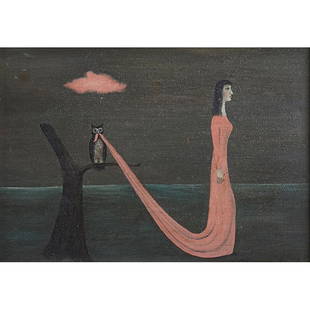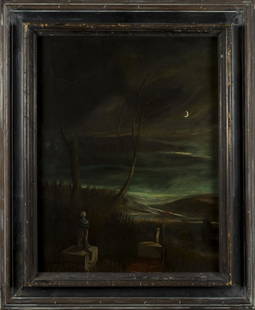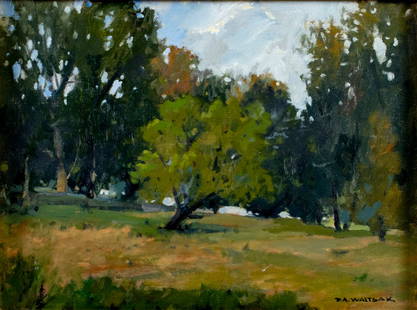
67114: Gertrude Abercrombie (American, 1908-1977) Lonel
Similar Sale History
View More Items in Paintings
Related Paintings
More Items in American Paintings
View MoreRecommended Art
View More




Item Details
Description
Gertrude Abercrombie (American, 1908-1977) Lonely House, 1938 Oil on canvas 36 x 30 inches (91.4 x 76.2 cm) Signed, titled, dated, and inscribed on the reverse: Gertrude Abercrombie / Lonely House / sept. 1938 / EAP / 2108 Property from the Collection of Kirkland Fine Arts Center, Millikin University, Decatur, Illinois EXHIBITED: Illinois Art Gallery, Chicago, Illinois, and elsewhere, "Gertrude Abercrombie: An Exhibition," March 18-May 17, 1991. LITERATURE: S. Weininger, Gertrude Abercrombie: An Exhibition, exhibition catalog, Springfield, Illinois, 1991, pp. 32, 89, illustrated. We wish to thank Dr. Susan Weininger, Professor Emerita, Roosevelt University, for preparing the following essay: Lonely House is large, early work by Abercrombie, characteristic of this period in her career. Done for the Illinois Arts Project (IAP) of the Works Progress Administration (WPA) in 1938, it was acquired by Milliken University in Decatur, Illinois. The solitary red brick house sits on a slight rise in a deep landscape against the background of a dark moody sky with a full moon; a single leafless tree stands beside the house and a tiny figure is seen almost at the horizon line, all elements that are characteristic of Abercrombie. Although she had begun to paint in the early 1930s, the appointment to the earliest government supported art project, the Public Works of Art Project (PWAP) in 1934, followed by her appointment to the IAP the following year was the real beginning of her career as a painter. For the 25-year-old Abercrombie, this appointment validated her as an artist, and the regular paycheck allowed her to live independently from her parents for the first time. She rented an apartment in the Weinstein Building in the Hyde Park neighborhood of Chicago where she met many visual artists, writers and other creative people, some of whom became her lifelong friends. She was also able to express herself in ways that were not possible while living with her very strict parents who, as practicing Christian Scientists, objected to smoking, drinking and the general carousing that Abercrombie would embrace in her life. Seen as an image of rural or small town midwestern America, Lonely House conforms to the "American Scene" subject matter promoted by the government supported arts projects. This was an attempt to create a truly American art in a recognizable, naturalistic style that was accessible and easily understood (as contrasted with more abstract European movements such as Expressionism, Cubism, or Futurism) by a wide audience. Regionalist depictions of small towns and the bucolic countryside, such as those of Thomas Hart Benton, John Steuart Curry, and Grant Wood, embodied the aspirational values of peace, tranquility and fertility free from the Depression that was ravaging the country at this time. Although Abercrombie did paint some images that clearly feature these qualities (see Out in the Country, 1939, Whitney Museum of American Art, for example), Lonely House represents something else. Abercrombie was not an artist who dealt with contemporary political or social issues in her work, even if her images often look similar to the midwestern landscapes of both the boosters and critics of the time. Lonely House is, like many of Abercrombie's paintings, a deeply personal reflection that incorporates many of the themes that she returns to for the rest of her productive life. For her, the model for the countryside was the small western Illinois town of Aledo, where her father's extended family lived. She spent sporadic periods of time in Aledo before her family settled permanently in Chicago in 1916 (when she was 7 years old), after which she continued to spend summers there. As an only child, the warm extended family that included cousins who were like surrogate siblings provided her with a warmth and security she did not get from her strict and demanding mother. Lonely House is not a positive and uplifting image of the fertile Midwest, nor a comment on the ravages of the Depression. It is, like the austere and closed interior spaces that were a regular theme throughout her career, a kind of psychic self-portrait, a contrast to the public persona she presented at the regular parties she hosted at her house where she was the center of attention, reigning as the "Queen of Chicago", holding court among her numerous admirers and friends. In her art she confronted her internal life, rife with insecurity, confusion, loneliness and fear. In the rooms, modelled on her first apartment (without the vast clutter attested to by her friends), there is no exit from the simple rectangular box; even the doors often seen on the back wall are hingeless and tightly closed. The Lonely House can be seen as the exterior of one of those rooms. The desolation of the landscape, the isolation of the building, the brewing storm in the atmosphere all express a profound inaccessibility. The house itself, a narrow red brick structure with a slanting roof, has not one, but three doors all tightly closed and hingeless like those in her interiors. None of the doors really gives access to the house, a point underscored by the door on the upper level that does not have a stairway or a path leading up to it as do those on the ground and second level. The steep staircase is one that Abercrombie repeated in a number of works a decade later, significantly unattached to any building, another indication of instability (for example, Dilemma, 1947, Private Collection or Between Two Camps, 1948, Illinois State Museum, Springfield). The sadness of Lonely House is augmented by the leafless tree and the tiny figure placed deep in the background. Abercrombie said "It is always myself that I paint" and indeed this figure, dressed in black with a wide brimmed hat, is one seen in many of her works. The witchlike appearance of the figure is also characteristic of Abercrombie, who took on this persona frequently in her work (and life, often donning a pointed hat while out in the neighborhood). The witch, along with her other guise, the Queen, were among the limited ways in which a woman could exert power in the world, and Abercrombie cloaked herself in them in reality and in the imaginative world of her art. The isolation of this figure set in a vast empty landscape resonates with the house itself, echoing its impenetrable solitude. In Lonely House we have a resonant and haunting image of a solitary, deserted structure that reflects the inner life of the artist in a way that engages the viewer with its evocative power, so characteristic of the magic of Abercrombie. Susan Weininger, Professor Emerita Roosevelt University
HID03101062020
© 2022 Heritage Auctions | All Rights Reserved
Condition
Unlined canvas. Water stain visible along the extreme lower edges, verso. 1 inch area repair along the lower right edge. Lifting and flaking along lower left edge and in the shadow of the staircase. Stretcher bar lines visible, with a faint indentation in the canvas along the lower right corner. Faint 2 inch scuff in the door and a faint 4 inch scuff in the center of the house. Faint hairline craquelure, most notable in the dark shadows in front of the house. Under UV exam, there appears to be an area of fluorescing in the sky, left of the door, and a few minor spots along the extreme edges of the canvas.
Framed Dimensions 37.25 X 31 Inches Heritage Auctions strongly encourages in-person inspection of items by the bidder. Statements by Heritage regarding the condition of objects are for guidance only And should Not be relied upon as statements of fact, And do Not constitute a representation, warranty, Or assumption of liability by Heritage. All lots offered are sold "As Is"
Buyer's Premium per Lot:
25% on the first $300,000 (minimum $49), plus 20% of any amount between $300,001 and $3,000,000, plus 15% of any amount over $3,000,001 per lot.
Framed Dimensions 37.25 X 31 Inches Heritage Auctions strongly encourages in-person inspection of items by the bidder. Statements by Heritage regarding the condition of objects are for guidance only And should Not be relied upon as statements of fact, And do Not constitute a representation, warranty, Or assumption of liability by Heritage. All lots offered are sold "As Is"
Buyer's Premium per Lot:
25% on the first $300,000 (minimum $49), plus 20% of any amount between $300,001 and $3,000,000, plus 15% of any amount over $3,000,001 per lot.
Buyer's Premium
- 25% up to $300,000.00
- 20% up to $3,000,000.00
- 15% above $3,000,000.00
67114: Gertrude Abercrombie (American, 1908-1977) Lonel
Estimate $60,000 - $80,000
43 bidders are watching this item.
Shipping & Pickup Options
Item located in Dallas, TX, usSee Policy for Shipping
Payment

Auction Curated By
.jpg?width=140&aspect_ratio=100:101&quality=70)
Senior Vice President, American Art
Related Searches
TOP































































![[SEX] LOT OF 9 PHOTOGRAPHS SOLD TOGETHER: [SEX] A lot of 9 photographs sold together. Some postcards. One mounted with plastic corners in archival mat. Prints: 4.5" x 3" - 6" x 4". Generally good condition, various imperfections. *Additional](https://p1.liveauctioneers.com/8124/329546/177689790_1_x.jpg?height=310&quality=70&version=1715469494)

![Emilio Grau-Sala "Sur la Plage" Oil on Canvas: Emilio Grau-Sala (Spanish, 1911-1975), "Sur la Plage" [On The Beach], Oil on Canvas, 1958, signed "Grau Sala" lower right, signed, inscribed "Trouville", dated, and titled to verso. Image: 21.5" H x 2](https://p1.liveauctioneers.com/5649/328023/176731071_1_x.jpg?height=310&quality=70&version=1714409606)











